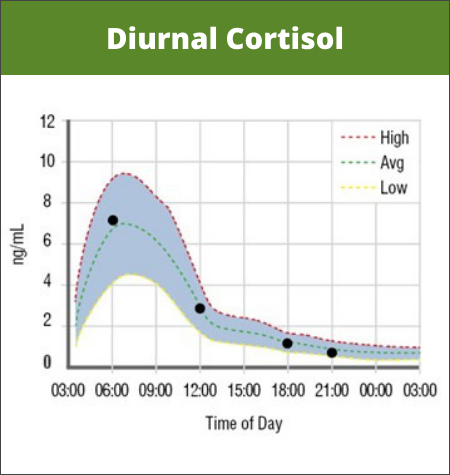Do you feel like your energy levels are out of sync with the rhythm of your day?
Maybe you wake up exhausted, yet are wired when it’s time to go to sleep.
Perhaps you bolt awake, tense and on edge, and never quite relax.
Or maybe you’re dragging all day long and never feel like you get going.
These are all signs that your cortisol levels and hypothalamic-pituitary-adrenal axis (HPA axis) are out of balance! Let’s look at what that means, root causes to consider, and how you can get back to waking up refreshed and full of energy!
Your Natural Cortisol Curve
Our bodies were designed to be in tune with the natural rhythm of the day. Sunlight signals the release of hormones in your adrenal glands (including cortisol) that help us wake up and feel energized and sunset triggers the release of melatonin to help us fall asleep.
A normal cortisol response should look like a curve. It rises first thing in the morning, peaks 30 minutes after you wake up, and slowly decreases throughout the day. It reaches its lowest point at night so you can relax and go to sleep.

The Cortisol Awakening Response
The transient peak shortly after waking up is known as the Cortisol Awakening Response (CAR). It is unique to the stimulus of morning waking, meaning it doesn’t occur at wakings in the middle of the night or following a nap.
The CAR provides direct insight into how the brain and adrenal glands are communicating and HPA axis resiliency. It reflects a person’s ability to cope with anticipated challenges and their perception of control around chronic stress.

A 50% increase is considered normal. If the increase is not that high, it’s deemed a blunted response. This is associated with an under-active HPA axis and is seen often in people with clinical burnout, material hardship, early loss experiences, PTSD, depression, and chronic health problems.
On the opposite end of the spectrum, if the increase is greater than 50% this is a sign of an overactive HPA axis. It can be due to anticipatory stress (such as ongoing job or relationship stress), blood sugar dysregulation, or pain. Many people with an overactive HPA axis feel they are on edge all day.
What Causes a Wonky Cortisol Curve?
Dysregulation in the HPA axis can present in a number of different forms. Your CAR may be blunted or high. Your cortisol levels may start off low and then peak in the evening or the middle of the night, causing insomnia. Alternatively, you may find yourself exhausted from sun up to sun down if your cortisol levels are below baseline all day.
Exactly how the dysfunction presents can provide clues to what’s causing the imbalance and how to best correct it. This is why I always recommend comprehensive adrenal testing (more on this below) in cases of suspected adrenal dysfunction.
A few of the most common causes include:
- Chronic stress – Extended periods of stress can keep your cortisol levels elevated for too long, cause them to spike precipitously, and eventually deplete them. This can lead to an underactive HPA axis and adrenal fatigue.
- Blood sugar dysregulation – Wild swings in blood sugar can cause your cortisol levels (and thyroid hormones) to go haywire. If your blood sugar gets too low, cortisol production increases to raise it, which can throw off your natural rhythm. This can be a problem in patients with insulin resistance or who eat lots of refined sugar and simple carbs, but it can also occur in those eating a “healthy” low-carb diet who don’t tolerate it well.
- Chronic inflammation – Inflammatory conditions and increased inflammation due to toxins, a poor diet, and excess weight can signal a prolonged increase in cortisol production.
How to Test Your Cortisol Levels
In order to best treat adrenal dysfunction, we need a clear picture of what is going on.
After years of reviewing cortisol tests with hundreds of patients, I’ve found the Adrenocrtex Stress profile to be the gold standard for adrenal testing. It provides your overall cortisol curve throughout the day with levels taken at four key points over 24 hours. It also evaluates your Cortisol Awakening Response (CAR) 30 and 60 minutes after waking.
With this information, we can drill down into what’s causing the HPA axis dysregulation and provide targeted support at key times in the day in the form of supplements, nutrition, and lifestyle strategies.
GrassRoots now offers an Adrenal Health Package that includes the at-home test and a private functional medicine consult to review your lab results and provide a personalized protocol to restore adrenal balance.
If you’re ready to regain control of your energy and stress levels, learn more and sign up here.
About the Author: Dr. Seth Osgood is a Doctor of Nursing Practice, Board Certified Family Nurse Practitioner and Institute of Functional Medicine (IFM) Certified Practitioner. Dr. Osgood received his post-graduate training in Functional Medicine through the IFM and from working with Dr. Amy Myers. He has helped people from around the world improve their health utilizing a Functional Medicine approach.





